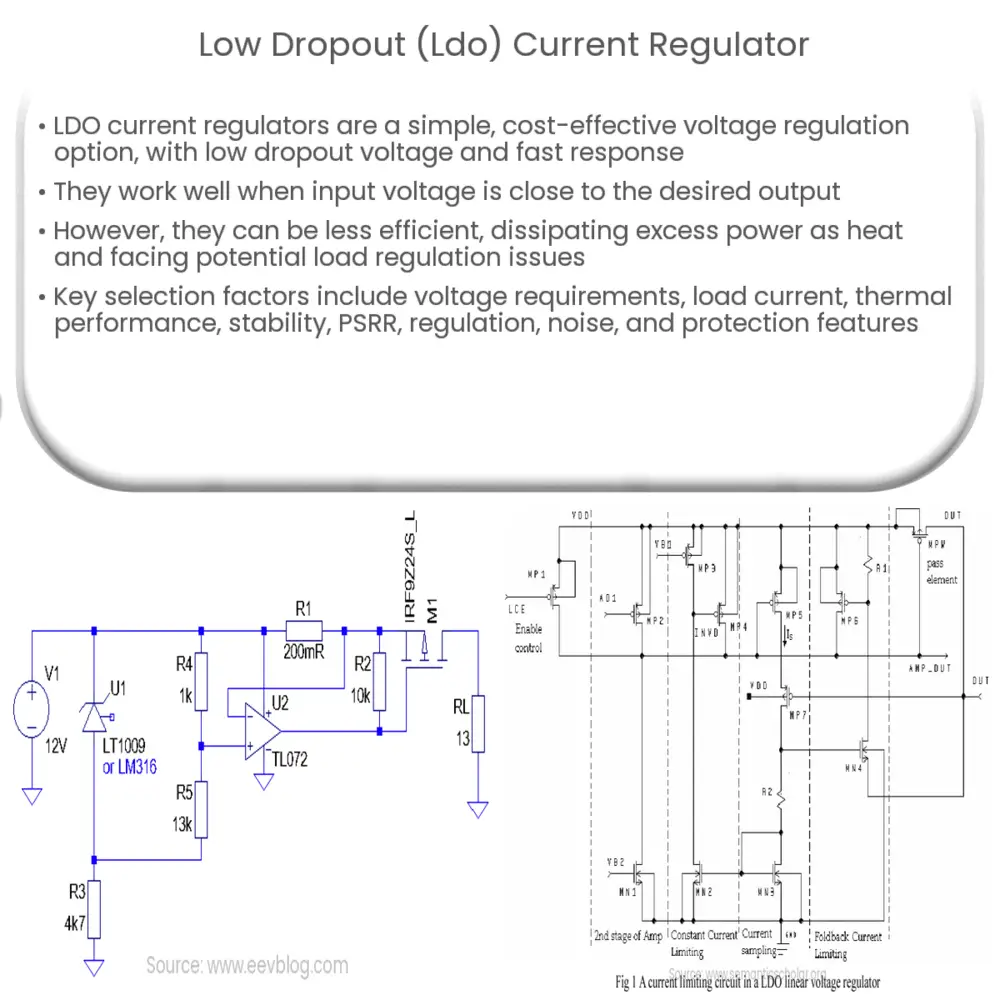An LDO current regulator is a low-cost, low-noise linear voltage regulator that maintains stable output voltage with minimal input-to-output difference.

Understanding Low Dropout (LDO) Current Regulators: An Introduction
Overview
Low Dropout (LDO) current regulators are a type of linear voltage regulator known for their simplicity, low cost, and ability to provide a stable output voltage with minimal input-to-output voltage difference. As electronic devices continue to advance and require lower voltage levels and more stringent regulation, LDOs have become a popular choice for designers. In this article, we’ll provide an introduction to LDO current regulators, their advantages and disadvantages, and some key considerations for their application.
What is an LDO Current Regulator?
An LDO current regulator is a specialized linear voltage regulator that maintains a constant output current by controlling the output voltage across a load resistor. The primary difference between an LDO and a traditional linear regulator is the low dropout voltage, which allows the LDO to operate with a minimal difference between the input and output voltages. This characteristic makes LDO current regulators ideal for applications where the input voltage may be close to the desired output voltage, and tight regulation is needed.
Advantages of LDO Current Regulators
There are several benefits to using LDO current regulators in electronic circuits:
- Low Dropout Voltage: LDOs can operate with a minimal difference between input and output voltages, making them suitable for applications with low headroom.
- Simple Design: LDOs are relatively simple in design, often requiring fewer external components compared to other types of voltage regulators. This can lead to lower overall costs and reduced complexity in circuit designs.
- Low Noise: LDO current regulators produce less noise than their switching counterparts, which can be beneficial in sensitive analog or mixed-signal applications.
- Fast Transient Response: LDOs can quickly respond to changes in input voltage or load current, providing a stable output in dynamic operating conditions.
Disadvantages of LDO Current Regulators
Despite their advantages, there are some downsides to using LDO current regulators:
- Lower Efficiency: LDOs dissipate excess power as heat, which can result in lower efficiency compared to switching regulators, especially in high input-to-output voltage difference applications.
- Thermal Limitations: The heat generated by an LDO can lead to thermal issues, which may require additional heat sinking or other thermal management solutions.
- Load Regulation: LDOs can experience degraded load regulation performance at high output currents, which may limit their suitability for some applications.
Key Considerations for LDO Current Regulator Applications
When selecting an LDO current regulator for a specific application, it’s important to consider several factors:
- Input and Output Voltage Requirements: Ensure the LDO’s input voltage range and dropout voltage meet the needs of your application.
- Load Current: Choose an LDO with a maximum output current rating that meets or exceeds your application’s requirements to prevent overheating or damage to the regulator.
- Thermal Performance: Take into account the power dissipation and thermal requirements of your design to ensure safe and reliable operation of the LDO.
Stability and Compensation
One critical aspect to consider when working with LDO current regulators is stability. LDOs typically require an output capacitor for stability, and the type, value, and ESR (Equivalent Series Resistance) of the capacitor can significantly impact the regulator’s performance. It’s essential to follow the manufacturer’s recommendations for selecting the appropriate output capacitor to ensure stable operation.
Power Supply Rejection Ratio (PSRR)
PSRR is a measure of an LDO’s ability to reject input voltage ripple and noise, ensuring a clean and stable output voltage. High PSRR is particularly important in applications where the input voltage may be subject to noise or fluctuations, such as battery-powered devices or systems with multiple voltage rails. When selecting an LDO, consider the PSRR performance at the frequencies of interest for your application.
Line and Load Regulation
Line regulation refers to the ability of an LDO to maintain a constant output voltage as the input voltage varies, while load regulation refers to maintaining a constant output voltage as the load current changes. Good line and load regulation are essential for ensuring stable output voltage across varying operating conditions. Carefully review the line and load regulation specifications of the LDOs under consideration to ensure they meet your application’s requirements.
Output Noise
While LDO current regulators are generally low-noise devices, some applications may require even lower noise levels. In these cases, it’s essential to consider the output noise specifications of the LDOs you’re evaluating. Some LDOs offer ultra-low output noise or include noise reduction features such as an external noise reduction pin, which can help achieve the desired performance in noise-sensitive applications.
Protection Features
Many LDO current regulators include built-in protection features to ensure safe and reliable operation. Some common protection features include:
- Thermal Shutdown: Protects the LDO from overheating by shutting down the device when a specified temperature threshold is exceeded.
- Current Limiting: Limits the output current to a safe level to prevent damage to the LDO or the load in case of a short circuit or overload.
- Reverse Voltage Protection: Protects the LDO and downstream components from damage due to reverse voltage conditions, such as when a power supply is connected in reverse.
Consider your application’s specific requirements and choose an LDO with the appropriate protection features to ensure a robust design.
Conclusion
Low Dropout (LDO) current regulators offer a simple, cost-effective solution for voltage regulation in a wide range of applications. By understanding the key factors and considerations when selecting an LDO, such as input and output voltage requirements, load current, thermal performance, stability, PSRR, line and load regulation, noise, and protection features, you can choose the right LDO for your application and ensure a stable and reliable design.

